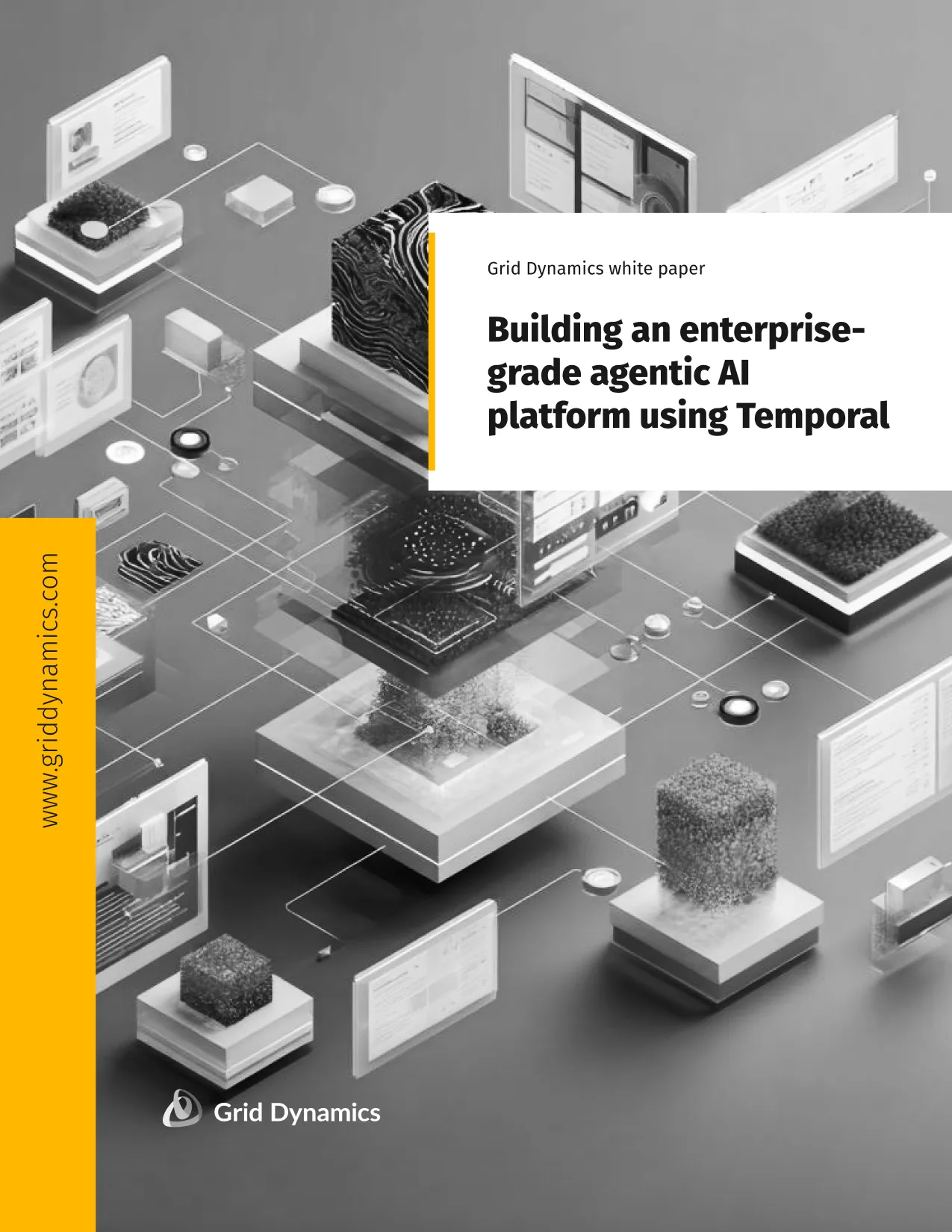Dmitry Mezhensky
Director of Big Data and ML Engineering
Dmitry Mezhensky joined Grid Dynamics in 2014 and has worked on various Big Data projects since. One of the major projects, iCrossing, was a huge success as we built a high-performing Big Data platform. Dmitry is currently on-site at a large retailer.
Check out the latest insights
An IoT data knowledge graph connects disjointed manufacturing data from machines, sensors, warehouse management systems, enterprise resource planning systems, and more into one contextual view. This Data Contextualization capability extends the existing Agentic AI IoT Control Tower solution by auto...

Running agent-based systems across your enterprise comes with tough problems. The main ones are keeping costs down, scaling up fast, and making sure nothing breaks when things go wrong. This white paper gets into the real challenges that come up when teams move from simple agent pilots to a ful...
This Temporal Agentic AI Platform demo shows you how enterprises build scalable, reliable agentic AI systems with strong guardrails and real-time observability. The platform orchestrates multiple AI agents that generate and query knowledge graphs from source code, analyze complex data pipeline depe...

From retail to manufacturing, and from financial services to healthcare, every industry is eager to capitalize on the potential of artificial intelligence. But AI-ready data is essential to realizing that promise. To truly unlock that potential, AI solutions for enterprises must be built on a fou...

Discover how to transform LLM prototypes into powerful commercial solutions with LLMOps & RAG. Download our free ebook for expert strategies and insights.

An average company adopting cloud today could achieve 180% ROI in business benefits, although few are getting close to these returns. Migrating or replatforming to a cloud data platform is a complex process. Even a basic "lift-and-shift" migration requires careful planning—designing the target...

Deploying open-source large language models (LLMs) like Mixtral-8x7B, Mistral, and Llama 2 requires a significantly different LLMOps architecture compared to using closed-source models from providers like OpenAI, Google, and Anthropic, even though data vectorization, embeddings creation and observa...

In a dynamic world where advertising success depends on data-driven decisions, the partnership between Yieldmo, a digital advertising platform, and Grid Dynamics has birthed a groundbreaking solution–a scalable, configuration-driven Machine Learning Platform. This innovative platform addresses...
Co-created by Grid Dynamics Director of Data Engineering, Dmitry Mezhensky, and Yieldmo Head of Analytics and Data Science, Sergei Izrailev Yieldmo, a Grid Dynamics client, is an advertising platform that helps brands improve digital ad experiences through creative tech and artificial intellig...

Building solutions using closed-source large language models (LLMs), including models like GPT-4 from OpenAI, or PaLM2 from Google, is a markedly different process to creating private machine learning (ML) models, so traditional MLOps playbooks and best practices might appear irrelevant when appl...

The diversity of modern data technologies leads to new challenges in establishing a consistent and accurate data view for data consumers. In light of this issue, a semantic data layer introduces a means of harmonizing a single point of view for business metrics, no matter how many different data...
MLOps and DataOps principles, such as infrastructure-as-a-code management, continuous integration and continuous delivery, proper monitoring, and a standard approach to working with data assets, are essential components of a modern data estate. In this case study, we show how we helped a global...

In today's data-driven world, efficiently managing data is critical to business growth and competitive advantage. However, many organizations struggle to extract maximum value from their data due to outdated data architectures that limit their ability to store, process, and analyze large volumes of...

Industrial IoT (IIoT) has become mainstream in a broad range of industries, including manufacturing, supply chain, logistics, energy, smart cities, and agriculture. IoT solutions enable intelligent decision-making for use cases such as predictive maintenance, visual quality control, and anomaly det...

Adoption of machine learning (ML) methods across all industries has drastically increased over the last few years. Starting from a handful of ML models, companies now find themselves supporting hundreds of models in production. Operating these models requires the development of comprehensive capa...

Without data observability in their production pipeline, this Fortune 500 manufacturer encountered multiple data issues that drastically impacted time-to-market, added significant development overhead, and complicated the product development roadmap. A data observability solution simplified, accele...

Over the past decade, the complexity of manufacturing processes and assembly lines have significantly increased. Whereas in the past, businesses relied on linear assembly lines, today’s assembly lines can produce customized products, as seen in the automotive industry. However, introducing customiz...

Modern enterprises operate with tremendous amounts of data, and data management has become an integral part of business decision-making processes, KPI management and reporting. However, getting advanced insights from data and ML models is a sophisticated process that many companies still stru...
Data quality control is a mission-critical capability for virtually any modern enterprise. Why? Because data quality issues can disrupt business processes and services, invalidate any type of analytics performed in the company, and damage a company's reputation. However, despite the importance of d...

On their quest to future-proof their smart manufacturing operations and create a more connected, predictable environment, Jabil Inc, a leading global manufacturing solutions provider, required a cloud-native data platform to meet these goals. Grid Dynamics, partnering with AWS, took the task hea...

Modern business intelligence (BI) tools provide users with a wide range of data consolidation, preparation, querying, and reporting capabilities that empower them to make better business decisions. However, the adoption process is non trivial even for the leading BI solutions. In this article...

Every business is focused on a rapid time to market and return on investment. It’s no longer enough to implement a data lake, businesses require a data platform that can provide immediately actionable insights. But building a data platform from the ground up can take a significant amount of tim...

Every company wants to take advantage of their data to turn it into actionable insights. It can be used to build customer 360, reduce customer churn, plan marketing campaigns, and optimize pricing, inventory, and supply chain. Data is also key to increasing productivity and the efficiency of the wo...
After the initial excitement that data lakes would help companies maximize the utility of their data, many companies became disillusioned by rapidly diminishing returns from their big data efforts. While it was easy to put large volumes of data in the lakes, turning that data into insights and real...
Over the last ten years, the role of data in modern enterprise has continued to evolve at a rapid pace. Companies launched initiatives to define and execute their data strategy, appointed Chief Data Officers, and created large teams to collect, manage, and generate insights from data. With increase...

In early 2016 one of our online media customers came to us with a problem. Our customer, a media giant, hosts articles from its newspapers and magazines on its websites. Each of the articles’ web pages has three ad blocks, and the customer buys paid redirects to the article pages. They then analyze...











